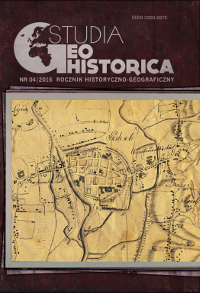Ślady średniowiecznej granicy Warmii między Reszlem a Świętą Lipką
Traces of the Medieval Border of Warmia between Reszl and Święta Lipka
Author(s): Robert KlimekSubject(s): Regional Geography, Historical Geography
Published by: Polskie Towarzystwo Historyczne
Keywords: Warmia;granica Warmii;kamienie graniczne; border of Warmia;border stones
Summary/Abstract: The diocese of Warmia was established on July 28th, 1243, when the region of Prussian lands was divided into four dioceses: of Chełm, of Pomorze, of Warmia, and of Sambia. The bishopric of Warmia was to be endowed with a third of estates belonging to the diocese, whereas the remaining part was to be in the possession of the Teutonic Order. The division of the Warmia diocese into parts belonging to the bishopric and the Knights proceeded in several stages: the initial agreement was reached on April 27th, 1251; further arrangements were decided on December 27th, 1254. The last document states that the eastern border reaches up to the Krakocin forest lying one mile to the east of Reszl. In the 2nd half of the 14th c. serious arguments followed regarding the location of the border between the estates of the bishopric and the Order. Ultimately, on July 28th, 1374, an agreement was signed and approved of by Pope Grzegorz XI, setting favourable conditions for the Order. The historic border of Warmia between Święta Lipka and Reszl proves an extremely interesting issue. It includes many border stones and mounds which have survived up until today virtually in an unchanged form. Of particular interest is a border stone made of red granite, with an episcopal crosier and cross carved into it. The object was listed in a document from 1431. All border stones enumerated in the publication are featured in archival maps from the turn of the 16th c. Alongside border stones, objects of interest lying on the historic border of Warmia are longitudinal shafts. Two stretches of this type of fortifications have survived up until the present times. Yet another curiosity are the forest ducts running across the former border, two of which used to be of an inter-regional importance. The border of Warmia in the region of Święta Lipka runs across forested areas, which is the reason why most border Stones have survived until today. The hitherto expert literature on the subject includes no mention of these – the present publication constitutes an attempt to verify the course of this stretch of the Warmia border, on the basis of source materials and cartographic documents. The section of the border discussed here, located in the vicinity of an important religious site of Święta Lipka is of great significance in terms of its cultural and historical value.
Journal: Studia Geohistorica
- Issue Year: 2016
- Issue No: 4
- Page Range: 38-50
- Page Count: 13
- Language: Polish

